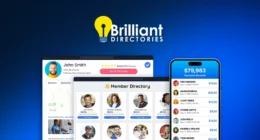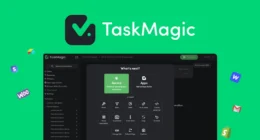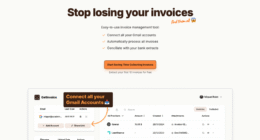Popular budgeting software options like QuickBooks, Budgyt, and Scoro help small businesses track expenses and manage finances efficiently. These solutions offer automated expense tracking, real-time dashboards, and integration with existing accounting systems. QuickBooks stands out for its exhaustive features and affordability, while Budgyt excels in team collaboration, and Scoro combines budgeting with project management. Pricing ranges from $26 to $83 per month, depending on features and user count. Exploring these tools reveals additional capabilities that can transform business financial management.
Quick Overview
- QuickBooks offers comprehensive budgeting tools with accounting integration, making it an ideal choice for small businesses needing all-in-one financial management.
- Float specializes in cash flow forecasting and integrates with popular accounting platforms, helping small businesses plan and manage finances effectively.
- PlanGuru provides professional-grade analytics and forecasting at an entry-level price point of $83/month for single entities.
- Budgyt features team collaboration tools and quick implementation, with extensive third-party integrations for seamless business operations.
- Scoro combines budgeting with project management capabilities, starting at $26 per user monthly for unified business and financial tracking.
Understanding the Essential Features of Business Budgeting Software

The essential features of business budgeting software serve as the foundation for effective financial management in today’s fast-paced business environment. Modern solutions combine real-time monitoring, automation, and powerful analytics to streamline financial operations.
Key capabilities that make these tools invaluable include:
- Automated expense tracking and categorization
- Real-time financial dashboards and alerts
- Integration with existing accounting systems
- Customizable templates for industry-specific needs
- Predictive modeling for future scenarios
These features work together to provide small businesses with thorough financial oversight. With projected market growth reaching $44.2 billion by 2030, businesses are increasingly recognizing the value of comprehensive budgeting solutions.
The software reduces manual work through automation, while offering scalability to accommodate growth. By connecting with other business systems and providing instant access to financial data, these tools enable informed decision-making and help prevent costly mistakes in budgeting and planning.
Top Software Options for Small Business Budget Management
With a solid understanding of core budgeting features, small business owners can now explore specific software solutions that match their financial management needs. Effective budgeting tools are crucial since informed financial decisions require comprehensive planning and tracking capabilities.
Several top options stand out in the market:
Today’s budgeting software market features diverse solutions tailored to meet varying business needs and financial management requirements.
- Budgyt offers focused budgeting tools with quick 5-10 day implementation and strong team collaboration features.
- Scoro combines budgeting with project management, featuring visual dashboards and real-time tracking.
- QuickBooks provides exhaustive accounting integration starting at $15/month, with automatic transaction categorization.
- Float specializes in cash flow forecasting at $35/month, integrating smoothly with popular accounting platforms.
- PlanGuru delivers advanced forecasting with over 20 methods and professional-grade analytics starting at $99/month.
Each solution offers unique advantages, from QuickBooks‘ affordability to PlanGuru‘s sophisticated forecasting capabilities, allowing businesses to choose based on their specific requirements.
Comparing Pricing Plans and Value Propositions

Small business owners face a complex landscape when evaluating budgeting software pricing plans and their associated value propositions. Entry-level solutions like Planguru’s single-entity plan ($99/month) offer basic functionality, while advanced platforms like Jirav ($1,667/month) provide extensive features for growing businesses. Traditional Excel-based budgeting approaches are risky due to high error rates, making dedicated software solutions a worthwhile investment.
The key is matching software capabilities with current needs while considering future scalability.
- Budgyt offers tiered pricing from $399 to $999 annually, making it accessible for various department sizes.
- Scoro’s per-user pricing model allows flexible team scaling at $19.95-24.95 per user.
- Lower-cost plans typically focus on essential budgeting features without advanced forecasting.
- Mid-tier solutions include better reporting capabilities and role-based permissions.
- High-end platforms integrate detailed scenario modeling and advanced analytics, justifying premium pricing.
Key Benefits of Implementing Budgeting Software
Through strategic implementation of budgeting software, businesses can liberate numerous operational and financial advantages that drive sustainable growth. The software streamlines financial processes by automating calculations, reducing human errors, and providing real-time insights into cash flow patterns. The intuitive user-friendly dashboards make financial data easily accessible to non-financial stakeholders across the organization.
Key benefits include:
- Enhanced accuracy through automated calculations and validation checks
- Improved efficiency by eliminating manual data entry and repetitive tasks
- Better cash flow management with predictive analytics
- Data-driven decision-making capabilities through advanced reporting
- Seamless integration with existing accounting systems
Small businesses particularly benefit from these features as they support scalability while maintaining financial health. The software’s ability to track spending patterns, identify cost-saving opportunities, and provide accurate forecasts helps organizations maintain sustainable growth while adapting to market changes.
Maximizing Software Integration for Business Efficiency

Successful business efficiency relies heavily on seamless software integration across all operational areas. When companies effectively integrate their budgeting software with other business systems, they create a unified ecosystem that enhances productivity and streamlines operations.
This integration enables real-time data sharing, automated workflows, and improved decision-making capabilities across departments. Real-time analytics provide immediate insights into market trends and operational performance. Automated data synchronization eliminates manual entry errors and reduces operational delays. Centralized dashboards provide thorough financial insights for better strategic planning. Integrated communication channels foster improved collaboration between teams. Connected CRM and financial systems enable more personalized customer service.
Streamlined workflows reduce operational costs while increasing overall productivity. This systematic approach to software integration helps small businesses maintain competitive advantages while reducing overhead costs and improving service delivery. The result is a more efficient, data-driven organization positioned for sustainable growth.
Emerging Trends and Future Developments in Budget Software
Modern budgeting software is experiencing five groundbreaking transformations that are reshaping how small businesses manage their finances. AI and machine learning are revolutionizing financial forecasting, while real-time insights allow companies to monitor and adjust their budgets instantly. The industry is moving toward customizable, industry-specific solutions that cater to unique business needs, from retail to manufacturing. Popular solutions like free accounting tools enable seamless bank integration and expense tracking for enhanced financial control.
Security concerns are being addressed through blockchain technology, which provides tamper-proof financial records and enhanced protection against fraud. Perhaps most notably, the shift to subscription-based models has made sophisticated budgeting tools more accessible to small businesses. With flexible pricing options and free tiers for startups, companies can now access powerful financial management features without breaking the bank. These modern tools help prevent the common pitfall of overly complex budgeting that often leads users to abandon their financial planning efforts altogether.
Frequently Asked Questions
How Long Does It Typically Take to Implement New Budgeting Software?
Implementation time for budgeting software varies based on several factors. Basic solutions typically take 5-10 days to set up, while mid-level software requires about 2 weeks.
Enterprise-level systems may need 1-3 months for full deployment. Cloud-based tools generally implement faster than on-premise solutions. The timeline depends on factors like software complexity, required customizations, number of integrations, and team readiness. Clear objectives and strong vendor support can help accelerate the process.
Can Multiple Team Members Access the Software Simultaneously?
Modern budgeting software is a digital meeting ground where multiple team members can indeed work together simultaneously. Most cloud-based platforms support concurrent access, allowing teams to collaborate in real-time from different locations.
Role-based permissions guarantee secure access levels for various team members, while features like real-time updates and notifications keep everyone in sync. Integration capabilities with tools like QuickBooks further enhance team collaboration possibilities.
What Security Measures Protect Financial Data in Cloud-Based Budgeting Software?
Cloud-based budgeting software employs multiple layers of security to protect financial data. These include AES-256 encryption for data storage and transmission, multi-factor authentication requiring users to verify their identity through multiple credentials, and SSL/TLS protocols for secure online exchanges.
Regular security audits, encrypted backups, and compliance with standards like SOC 2 and PCI DSS provide additional protection. Disaster recovery mechanisms safeguard data so that it can be restored if systems fail.
Is Staff Training Included in the Software Subscription Price?
While every software vendor seems to promise the moon when it comes to training, the reality is more down-to-earth. Basic training inclusion varies considerably across subscription tiers. Entry-level packages typically offer self-help resources and tutorials, while premium subscriptions include extensive training options.
Mid-tier plans often provide group webinars and basic onboarding support. Additional specialized training usually comes at extra cost, though some vendors offer pay-per-session options for budget-conscious businesses.
How Often Are Software Updates Released and Are They Included?
Most budgeting software releases updates every two months, though some providers offer more frequent weekly or monthly updates. These updates are typically included in the subscription price at no extra cost.
Updates commonly include security enhancements, new features like improved reporting tools, and better integration with other financial software. For subscription-based services, updates are automatic, while lifetime license holders may need to pay separately for major updates.
Conclusion
Like a skilled financial navigator charting the best course, choosing the right budgeting software can steer a small business toward success. The perfect solution balances robust features, seamless integration, and cost-effectiveness while adapting to evolving business needs. By carefully evaluating options, considering future trends, and implementing the selected software effectively, small businesses can transform their financial management from an intimidating task into a streamlined, strategic advantage.








